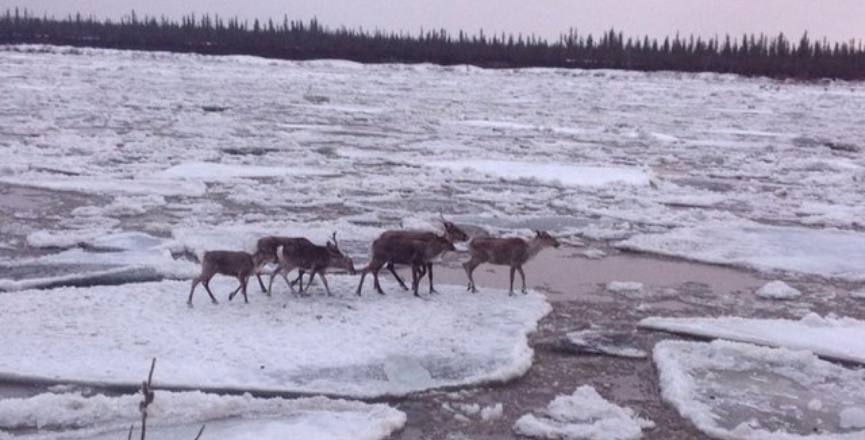Among all the outrages Donald Trump is committing — rushing federal executions at a record pace, pardoning his friends, and seeking to overturn the votes of Black, Indigenous and brown people — few have noticed how he has maliciously poked Canada in the eye on his way out the door.
Trump’s administration has invited oil and gas companies to bid on leases to drill in the environmentally protected Arctic National Wildlife Refuge (ANWR) in Alaska .
If you look at a map of Canada you will notice that the Alaska-Canada border in that region is a straight line, arbitrarily dawn. That border cuts through a large and ecologically vulnerable territory, home to the calving grounds of a shared resource, one of the largest caribou populations in the world, the Porcupine herd (named after the Porcupine River in the northern Yukon).
Since the late 1970s, both the Canadian and U.S. governments have protected this area.
In 1977, Judge Thomas Berger gave the Canadian government a report on plans to create a corridor down the Mackenzie River valley to carry oil and gas from Canada’s Beaufort Sea region, and potentially from Alaska, to market. The judge recommended a 10-year moratorium on any such project, to allow for the settlement of First Nations’ land claims, and added that the very northwestern portion of the territory, bordering Alaska, should be preserved in perpetuity, free of any industrial development.
The Canadian government of the day heeded Berger’s advice, and created the Ivvavik and Vuntut national parks. The U.S. government had created an early form of protection for the adjacent Alaska region as far back as 1960, and increased the protected territory in 1980, when it formally created ANWR. But U.S. rules have always left open the possibility of oil and gas drilling in at least part of the protected territory.
Trump’s decision threatens a vital and irreplaceable source of protein
Since his election, Donald Trump has tried to make that oil and gas activity happen, a process he accelerated after the 2018 midterms, which saw the election of some strong advocates of drilling.
Fortunately for the caribou, and for the Indigenous people who depend on them, the approval process can move slowly in the U.S., and Trump has had other priorities, such as undoing almost all of his predecessor Barack Obama’s climate-change-related regulations.
Now, with time running out, Trump is pushing the ANWR drilling process forward, hoping to make it irrevocable.
The outgoing U.S. administration has set in motion a secretive auction to sell oil and gas leases on ANWR land to interested companies. We will not know the result of this process until the government unseals the bids. Knowledgeable observers in Alaska say they expect that to happen on the eve of inauguration day for the next president.
These events are happening far from the everyday experience of the average Canadian or American. Imminent U.S. government decisions will have their impact in a remote and barely accessible region of Alaska, the Yukon, and the Northwest Territories.
But for the more than ten thousand members of the Gwich’in First Nation and several thousand Inuit of that region those decisions are a matter of survival.
As we reported in this space in 2018, high-quality store-bought food is difficult to come by and extremely expensive in that part of the Arctic. The people there all depend on what they call country food, which includes: fish, especially the whitefish, its large relative the inconnu (or cony), and the ling cod; wild berries, such as the low-bush cranberry (or lingonberry), which grows in profusion throughout much of the region; small game, including ptarmigan and arctic hare; and, of greatest importance, caribou.
The Porcupine caribou, which in 2017 numbered over 200,000 , have a complicated life cycle.
They spend part of the warmer months along the coast, where they have their young. They then migrate a distance of over 2,000 kilometres eastward, in search of food. Throughout their journey, they have to deal with predators such as grizzly bears, wolves, and of course, humans.
In the warmer weather, the caribous’ most vicious enemies are the swarms of mosquitos that attack them mercilessly. Their only defence against those small biting monsters is to immerse themselves in the rushing rivers of the region, which, in turn, pose great dangers of their own. Each year, a number of caribou are carried away by the torrents and drowned
Somehow, the vast herd has endured and even thrived. The people of the area are scrupulous to harvest only enough caribou to meet their needs, and not deplete the herd. They want the animals to return next year and the year after.
Every community feast and celebration in that Northern region includes caribou, and the people consume the whole animal. They make soup with the animals’ heads, for instance. Fresh, frozen or dried, caribou forms a key part of the daily diet throughout the region. It is the highest quality protein available to these northern Indigenous peoples.
Oil drilling, accompanied by roads and seismic blasting, would happen right on the calving grounds. It would disrupt the herd at the most sensitive period of their annual life cycle, and could have a fatal effect.
It would be worse than a tragedy if the future of an environmentally precious region, and the people who live there, were to become victim of a wounded leader’s anger and hubris.
In general, the Canadian government probably has good reason to keep its powder dry, for the next two months, when it comes to relations with the U.S.
However, in the case of Trump’s plan to promote oil and gas drilling in a shared, protected territory, our government has no choice but to find the courage to speak out, forcefully and quickly.
Karl Nerenberg has been a journalist and filmmaker for more than 25 years. He is rabble’s politics reporter.




